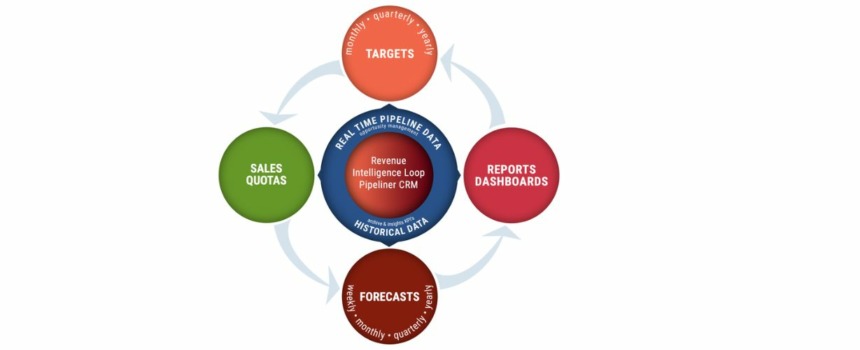This month, Pipeliner is introducing an unparalleled sales forecasting approach: the Pipeliner Revenue Intelligence Loop!
Read or listen to the full post:
As humans, we not only want to have an idea of where we’re coming from, but also where we’re going. We’re always engaged in a significant attempt to learn all about “what is next.” An example is, during election times, everyone scrambles to learn about political outcomes. A lighter example is the love everyone has for the motion picture Back to the Future—McFly and the professor are able to return to a time in the past, knowing everything that is going to happen.
Defeating Uncertainty in Business
Of course, uncertainty is the main worry for anyone trying to analyze or forecast the future. This is nowhere more evident than in business.
Companies need to realize today that competition is becoming so fierce because competitors are becoming better at predicting their gross revenue. To succeed in this new competitive environment, every company needs to revolutionize its sales function management.
Why is prediction so vital in business? Because prediction secures company investments and decisions, based on past data. It is, therefore, crucial that historical data be accurately analyzed. When this isn’t done, a company cannot accurately forecast and predict the future performance of the individual and the team.
Importance of Historical Data
In order to analyze historical data, a company must possess it to begin with. The more historical data a company has, the more accurate predictions will be.
It is for this reason that we generally market our Pipeliner CRM solution to companies with existing data. In order for data to be analyzed and for any accurate prediction to be made, a good couple of years of historical data is required.
Looking at our graphic above, you can see how this works in practice. Starting at the center of the Revenue Intelligence Loop, historical data is accumulated through sales management insights, KPIs and Archive functionality. These dynamic features provide evidence-based predictions Forecasting is no longer based on wishful thinking; ours is the first CRM in the market to make forecasting so precise.
Historical data must include combining leading and lagging indicators, which give you a full picture of your operation. Pipeliner fully incorporates leading and lagging indicators , giving you a holistic view.
As you can see in the graphic, this functionality coordinates with Pipeliner’s real-time pipeline data within its opportunity management to guide the company to meet its targets and quotas.
Using KPIs to Set Goals
In addition, several different KPIs within historical data need to be understood for the targets and quotas to be accurately set. For example, you must understand your average deal size. If you are setting a goal of $25 million in revenue, with 30 salespeople and an average deal size of $50,000, you will easily be able to figure out how to achieve the goal.
Other KPIs— all of which are included within Pipeliner —include sales velocity, targets, win rate, forecasting, and performance insights.
New Expanded Target Feature
As you can see in the graphic, historical data is utilized in the setting of monthly, quarterly and yearly targets—and in this regard, Pipeliner now provides greatly expanded target functionality.
With the new function, you can create user or group targets. As you’re setting the target, historical data is automatically filled in from KPIs of that individual or group—average deal size, win rate, average velocity, and the rest.
From this historical data, the target functionality will inform you of the target’s validity. Are there enough opportunities in the pipeline for this target to be made? Is it a realistic target, or unrealistic? From this data, you’ll be able to tell what actions are needed.
As you proceed through the sales period, you’ll always be able to see how far away the individual or group is from achieving the target. This is a powerful tool for management—but it is also a tool with which the individual sales rep can take self-responsibility. They can see they don’t have quite enough to fulfill a target, and take appropriate measures on their own.
Sales Management and Quotas
As you can see in the graphic, historical data is also used to set sales quotas. These are then assigned, depending on the sales structure of the company, to individuals, teams or territories. Pipeliner allows precise setting and assignment of quotas.
Forecasts
Once quotas are set, for the first time realistic forecasts can be created. These forecasts can be adjusted throughout the sales period to always remain accurate.
Reports
Pipeliner’s robust reporting system empowers sales management through its dashboard and advanced reporting capabilities.
Regular precise reports can be made to company leadership, stakeholders, or others who require them. Now that company leadership can operate with accurate forecasts, these can be provided to investors. Accurate predictions mean everything, especially within larger companies—if a company predicts $35 million in revenue, and only $25 million is made, that’s a loss of $10 million. In today’s economy, even a small percentage of error is unacceptable. A set of solutions such as Pipeliner’s Revenue Intelligence Loop can keep that from happening.
With the Revenue Intelligence Loop, we are now providing first-ever evidence-based predictions, and we have brought CRM back up to where it really should be, and what it was intended to be from the beginning. No longer will targets and forecasts be made based on guesswork. We’ve recently seen where lack of data and guesswork have taken us—simply look at the COVID disaster.
No more wishful thinking!
Start Your Free, No-Obligation 14-Day Pipeliner CRM Cloud Unlimited Trial.






















Comments